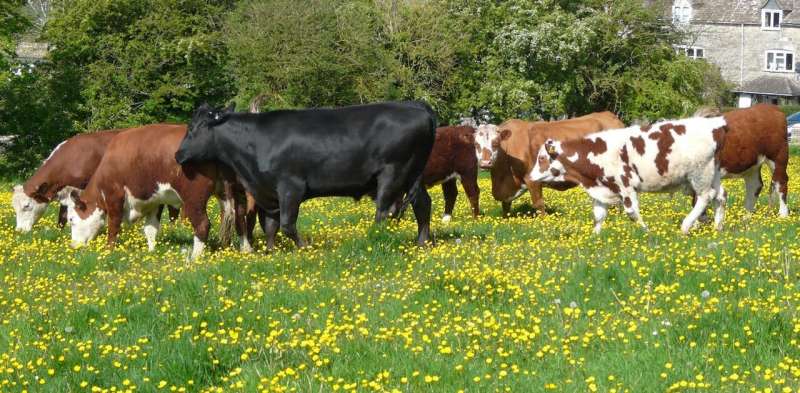This article has been reviewed according to Science X's editorial process and policies. Editors have highlighted the following attributes while ensuring the content's credibility:
fact-checked
trusted source
written by researcher(s)
proofread
Here's how much water it takes to make a serving of beef—and why where it comes from is so important

Almost everything we eat has consumed water somewhere in the process of being made and processed. But beef is credited with one of the biggest water footprints.
Our calculations
for British
But this figure doesn't tell you the full story about the water needed to produce the beef on your plate and the impact it has on the planet. Looking in more detail reveals that how and where the beef is farmed has a huge effect on its water footprint.
Food production accounts for 70% of freshwater withdrawn from the environment. Using large amounts of water to produce beef has been driving water scarcity in the western US, among other places.
And as climate change threatens longer and more severe droughts, it's important to scrutinize just how much water goes into making the food we eat.
So, how "thirsty" is beef? First, we have to differentiate between water from two sources. When we talk about water we usually think of rivers, lakes, reservoirs and groundwater aquifers.
This is what hydrologists call blue water. Consuming blue water to produce food depletes these water sources, leaving less for people's homes, industry and maintaining a healthy environment.
Green water on the other hand is rainfall that plants consume. In some countries, the plants which are ultimately fed to cows (grass for grazing, hay or silage and cereals) are mainly rain-fed, and green water accounts for a large part of the huge figures quoted for the water consumption of beef.
As green water cannot be repurposed (unless you covered the ground with a tarpaulin and managed to catch some of it), we don't consider its consumption as part of the impact of livestock production. We should concentrate on the blue water consumed instead, and the amount of blue water needed to produce a serving of beef is much less than the 15,000 liters quoted above.
What's the beef with blue water?
Blue water may be used to irrigate grass or other feed crops, in the feed processing industry, and on farms for drinking water and cleaning and to rinse abattoirs. Small amounts are used in other things, such as veterinary products, but these are trivial in comparison.
The amount of blue water it takes to get the meat on your plate depends on the animal's diet and the system that produced it. For the UK, we estimated a national average of 67 liters per kilogram of carcass.
This is relatively low, because most beef consumed in the UK is fed on rain-fed grass and crops. Production systems in the US, on the other hand, that rely on irrigated feed may consume almost 2,000 liters per kg. This is blue water that has been diverted from rivers and aquifers.
In addition to raising the animal, 700 liters to 1,000 liters of water is used per animal in the abattoir for washing and hygiene.
Not all of the carcass makes beef—some of it may make dog food and there's also inedible hide and bone—so the total water consumption has to be allocated among all the products. Producing a serving (375g) of English topside consumes 33 liters of blue water, 96% of which goes towards feeding and raising the animal.
The consequences of using water to produce food depend on where the water has come from and how much is available. In the UK, most beef production is concentrated in south-west England, Cheshire, north-west England, Wales, Scotland and Ireland—all wetter parts of the British Isles.
But most of the water cattle drink, and the water used to process their meat, comes from the public water supply where it competes with other demands. As of spring 2023, water restrictions are in place in parts of south-west England due to prolonged dry weather.
It's not just water
The 33 liters of freshwater needed to produce a serving of beef is more than ten times as much as the 2.3 liters required to grow the potatoes you might have on the side, though it is much less than the 73 liters used to produce an avocado in Peru for instance, or the 181 liters required to produce a serving of basmati rice in Pakistan.
But there are lots of other things to consider for a sustainable and healthy diet: water scarcity is just one of the many impacts of producing beef. Cows emit potent greenhouse gas emissions such as methane and growing the crops that feed them, such as cereals, consumes a lot of synthetic fertilizer which is usually made by burning fossil fuels.
In some circumstances, the grassland cows graze may be a net absorber of CO₂ from the atmosphere and unsuitable for other agricultural uses. But a great deal of forest and other habitats has been lost to make way for this pasture, and land used for growing cow feed could instead grow food for people. If poorly managed, slurry from livestock pollutes rivers.
To make informed choices about the impact of beef on the world's water, you need to know where the meat was produced. If you are eating beef from the western US, it could have a serious impact on how much water is available for everything else, whereas beef in Britain is more benign.
You would also need to know what the animal was fed, whether the feed was irrigated, where the water came from and how scarce water is in that region. At that point, you have to consider how to trade off water use with other environmental and social consequences.
Provided by The Conversation
This article is republished from The Conversation under a Creative Commons license. Read the original article.![]()





















